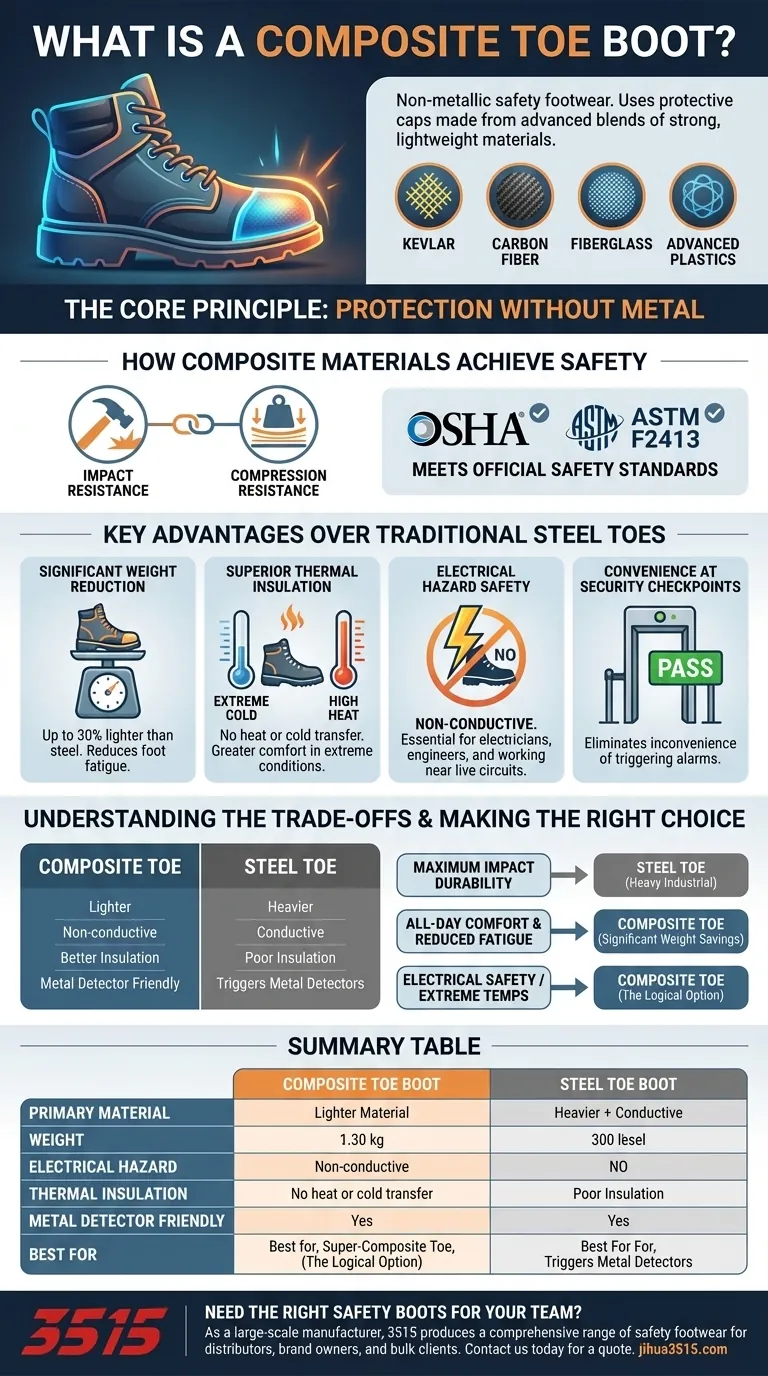A composite toe boot is a type of safety footwear that uses a protective cap made from non-metallic materials to shield your toes from impact and compression. Unlike traditional steel toe boots, these caps are crafted from a blend of strong, lightweight materials including Kevlar, carbon fiber, fiberglass, and advanced plastics.
The fundamental difference is this: Composite toe boots are engineered to meet the same official safety standards as steel toes but achieve this protection without using metal. This results in a lighter, non-conductive boot that excels in specific environments where metal is a liability.

The Core Principle: Protection Without Metal
The primary goal of a composite toe is to provide a certified safety solution for workers who cannot or prefer not to wear boots with metal components.
How Composite Materials Achieve Safety
Composite toe caps are designed to meet stringent safety requirements set by organizations like the Occupational Safety and Health Administration (OSHA) and comply with ASTM F2413 standards.
These standards test for both impact and compression resistance, ensuring the toe box can withstand significant force from a falling object or a crushing event.
The Key Materials at Work
The term "composite" refers to the combination of materials used.
- Kevlar: An aramid fiber known for its incredible strength-to-weight ratio.
- Carbon Fiber: Extremely strong and rigid yet very light, often used in aerospace and high-performance applications.
- Fiberglass & Plastic: Provide a durable, cost-effective, and lightweight structure for the toe cap.
Key Advantages Over Traditional Steel Toes
The absence of metal is not just a feature; it is the source of several distinct operational advantages.
Significant Weight Reduction
Composite materials are inherently lighter than steel. A composite toe boot can be up to 30% lighter than its steel-toed equivalent, which significantly reduces foot fatigue over a long workday.
Superior Thermal Insulation
Metal is an excellent conductor of energy. Composite materials are not.
This means composite toe boots do not transfer cold in freezing weather or heat in high-temperature environments, leading to far greater comfort in extreme conditions.
Electrical Hazard Safety
Because they contain no metal, composite toe boots do not conduct electricity. This is a critical, non-negotiable safety feature for electricians, engineers, and anyone working near live circuits.
Convenience at Security Checkpoints
For workers who frequently pass through metal detectors at airports or secure facilities, composite toe boots eliminate the inconvenience of triggering alarms.
Understanding the Trade-offs
While composite technology offers many benefits, it's essential to understand its limitations compared to steel.
Impact Resistance vs. Weight
Both composite and steel toe boots must pass the same ASTM safety standards to be sold as protective footwear.
However, steel is a denser material. While both protect against a single, major impact, steel can often withstand higher levels of impact force before failing. After a significant impact, a composite toe may be compromised, while a steel toe might only be dented.
Making the Right Choice for Your Work
Selecting the right boot depends entirely on the demands of your job and environment.
- If your primary focus is maximum impact protection in heavy industrial or construction sites: A steel toe may offer a slight edge in ultimate durability against extreme forces.
- If your primary focus is all-day comfort and reduced fatigue: The significant weight savings of a composite toe boot is the superior choice.
- If your primary focus is electrical safety or working in extreme temperatures: A composite toe is the only logical and safe option.
Ultimately, choosing the right safety boot is about matching the material's properties to your daily risks and requirements.
Summary Table:
| Feature | Composite Toe Boot | Steel Toe Boot |
|---|---|---|
| Primary Material | Kevlar, Carbon Fiber, Fiberglass, Plastic | Steel |
| Weight | Lighter (up to 30% reduction) | Heavier |
| Electrical Hazard | Non-conductive (EH rated) | Conductive |
| Thermal Insulation | Excellent (no heat/cold transfer) | Poor (conducts temperature) |
| Metal Detector Friendly | Yes | No |
| Best For | Electricians, HVAC, Airports, Extreme Temperatures | Heavy Industrial, Maximum Impact Durability |
Need the right safety boots for your team?
As a large-scale manufacturer, 3515 produces a comprehensive range of safety footwear for distributors, brand owners, and bulk clients. Whether you require the lightweight, non-conductive protection of composite toe boots or the ultimate durability of steel toes, our production capabilities encompass all types of safety shoes and boots to meet your specific needs and safety standards.
Contact us today for a quote and discover how we can equip your workforce with high-quality, reliable safety footwear.
Visual Guide

Related Products
- Safety Footwear Wholesale Manufacturer for Custom OEM/ODM Production
- Premium Flame-Retardant Waterproof Safety Boots and Shoes
- Durable Rubber-Soled Utility Shoes for Wholesale & Custom Brand Manufacturing
- Wholesale Safety Footwear Manufacturer for Bulk & Custom OEM Orders
- Wholesale Customizable Safety Boots Durable & Protective Footwear Manufacturing
People Also Ask
- Do snake bite boots work? Your Ultimate Guide to Effective Snake Bite Protection
- What are OSHA approved shoes? Understanding the Correct Standards for Workplace Safety
- What are the cultural perspectives on wearing shoes in the house? A Guide to Home Etiquette & Hygiene
- How do safety shoes contribute to cost savings for companies? A Strategic Investment in Risk and Cost Management
- Is it normal to wear shoes in the house? A Guide to Hygiene, Comfort & Culture



















